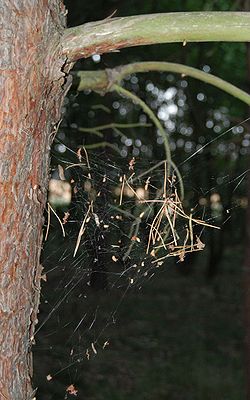Common moon spider
| Common moon spider | ||||||||||
|---|---|---|---|---|---|---|---|---|---|---|

Parasteatoda lunata (female) |
||||||||||
| Systematics | ||||||||||
|
||||||||||
| Scientific name | ||||||||||
| Parasteatoda lunata | ||||||||||
| ( Clerck , 1757) |
The common or common moon spider ( Parasteatoda lunata ), as the genus of the same name is often referred to simply as the moon spider , is a species of spider from the family of the canopy or ball spiders (Theridiidae). The very attractive color is widespread and frequent in Central Europe.
description
Males of the common moon spider reach a body length of about 3.0 mm, females 3.5 to 5.0 mm. As with all representatives of the genus, the abdomen ( Opisthosoma ) is higher than long. The basic color is very variable. The front part of the body ( prosoma ) is brown or red in color. The basic color of the opisthosoma is red or black-brown, on which the species shows a complex pattern. This consists of two small, white, angular spots on the upper side, a large, bright orange and broadly white bordered longitudinal spot on the sides and three large, yellow, crescent-shaped spots on the back. The legs are light beige and darkly ringed or solid red.
distribution and habitat
The common moon spider colonizes large parts of the Palearctic from Ireland and the Canary Islands to the east as far as Kamchatka and Japan . In the north-south direction, the distribution extends from Scandinavia to Israel and in the east to the south to China . The distribution area includes the boreal to Mediterranean zone. The species is absent in Europe in Iceland as well as in Greece . The species mainly inhabits rich and slightly damp deciduous forests and their edges.
Way of life
The common moon spider builds its web on tree trunks under thicker side branches, on the underside of sloping trees and in similar places that offer a certain cover from above. It usually hides in the net under loose parts of plants. Sexually mature animals are found from May to July.
Danger
The common moon spider is widespread and common in suitable habitats. In Germany it is classified as "safe" in the Red List .
swell
Individual evidence
literature
- Heiko Bellmann: Cosmos Atlas Arachnids of Europe . 3rd edition, 2006. Kosmos, Stuttgart. ISBN 978-3-440-10746-1
- Ralph Platen, Bodo von Broen, Andreas Herrmann, Ulrich M. Ratschker & Peter Sacher: Total species list and red list of spiders, harvestmen and pseudoscorpions of the state of Brandenburg (Arachnida: Araneae, Opiliones, Pseudoscorpiones) with information on frequency and ecology. Nature conservation and landscape management in Brandenburg 8, booklet 2 (supplement); 1999.
